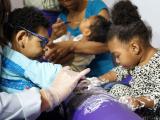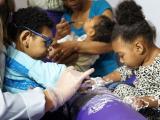Adding another layer of evidence for Zika infections and birth defects, two research teams today described the first experiments in infected pregnant animals, showing that in mouse models, the virus crosses the placenta and extensively damages fetal brains.
One of the studies also included two types of lab tests with human stem cells and "minibrains," which suggest that the Brazilian strain responsible for the outbreak in the Americas can cause more damage to developing cells than its African counterpart.
Experts have been eagerly anticipating the results from the first animal studies as they continue exploring the connection between the virus and its complications. The University of Wisconsin is among the research institutions conducting experiments on and closely monitoring pregnant macaques infected with Zika virus.
Researchers in both of today's mouse studies say the models they used could be useful for development of drugs and other therapies.
Evidence of broad damage from Brazilian strain
The mouse study that also included the two levels of in vitro experiments was done by a team from the University of California San Diego (UCSD) and collaborators from Brazil and Senegal. The findings appear today in an early online edition of Nature.
Alysson Muotri, PhD, one of the team's leaders and an associate professor in the departments of pediatrics and cellular and molecular medicine at UCSD, said today in a press release from the school that events in Brazil have shown a powerful association, but direct evidence has been lacking. "Our findings provide direct experimental proof that the Brazilian Zika virus strain causes severe birth defects—and that the full adverse effect upon health, even beyond microcephaly, is not yet fully understood," she said.
Similar to humans, mouse pups born to Zika-infected mothers had smaller-than-normal heads, one of the key microcephaly hallmarks, and stunted body growth. When the group analyzed tissue and gene samples, they found other problems such as eye abnormalities and further cell death.
Muotri said the tests on mice suggest that microcephaly is only the tip of the iceberg, given the extensive intrauterine growth development that the team found. "Media covering the Zika story have focused upon affected babies with small heads because such images are profoundly dramatic, but the true health impact is likely to be more widespread and devastating."
In at least one of the mouse strains they tested, Zika virus didn't cross the placenta, suggesting susceptibility might be related to genetic or immune-response differences.
In tests that compared the impact of Brazilian and African Zika virus strains on human pluripotent stem cells, which give rise to different fetal brain layers, the effects of cell death weren't as pronounced with the African strain, hinting that mutations in the Brazilian strain made it more aggressive in human cells.
Their experiments with human brain organoids—three-dimensional cell systems made in the lab to simulate different parts of the brain—also showed a greater degree of growth disruption and malformations with the Brazilian strain.
Using brain organoids from chimps to compare the adaptability of the two strains, researchers found that Brazilian Zika virus replicated more slowly, which Muotri said suggests that it has somehow adapted to humans. "We are investigating how genetic differences might cause that difference," she added.
Placenta replication clues, fetal abnormalities
In the second study, a team based at Washington University School of Medicine in St Louis developed two mouse models for testing Zika infection in pregnancy. Supported by the National Institutes of Health (NIH), they reported their findings today in Cell.
In one of the models, mice were genetically altered to lower their immune response to the virus. For the other model, the animals were given an antibody to block immune response.
After pregnant mice in the first group were infected with Zika virus, most fetuses died within a week, and the ones that survived had marked abnormalities, such as severely stunted growth. Viral levels in the placentas of the infected mice had levels 1,000 times greater than in the blood of pregnant mice, suggesting that the virus preferentially replicates in the placenta.
In the pregnant mice that were infected with the virus after receiving an antibody to blunt the immune response, the fetuses didn't die, but researchers saw growth impairment with viral material persisting in the developing heads and bodies through at least 16 days of embryonic development, a critical time for brain development.
According to an NIH press release, Michael Diamond, MD, PhD, who led the team, is planning studies with a team led by Helen Lazear, PhD, at the University of North Carolina at Chapel Hill to see if interferon-lambda can prevent Zika-infected pregnant mice from passing the virus to their fetuses.
Skin observations, Olympic risks, CCDM update
- New York researchers today detailed the dermatologic and histologic characteristics of a man who was diagnosed as having a Zika infection after returning from a visit to Puerto Rico. In JAMA Dermatology, they said they observed a scattered pink papular rash in the 44-year-old man, which descended from the trunk to the lower body. Petechiae were seen on the palate, and symptoms included bloodshot eyes.
- People who will travel to the Olympic and Paralympic games in August and September, respectively, are most at risk for gastrointestinal and vectorborne illnesses, the European Centre for Disease Prevention and Control (ECDC) said today in a risk assessment. In general, pregnant women and those considering getting pregnant should consider postposting nonessential travel, the agency said. The ECDC added that pregnant women planning to travel to the games and those living in affected areas should consult their health providers for advice and strictly follow steps to avoid mosquito bites. Travelers to Brazil and other affected areas should use condoms to reduce the risk of sexual Zika virus transmission, it added.
- Editors with The Lancet Infectious Diseases said today that the risk of Zika virus and its complications to Rio Olympic Games participants will be low, given that the venue is located in a relatively low-risk part of Brazil at a low-risk time of year. It noted that dengue transmission is typically low for when the games are slated to take place and that one modeling projection put the risk at 1 or 2 Zika cases among 1.8 million visitors, which doesn't include the risk of sexual transmission.
- An updated edition of Control of Communicable Disease Manual, a key resource for identifying and managing infectious diseases, includes a new chapter on Zika virus, the American Public Health Association said today in a press release. Available exclusively online in a new edition, the manual's Zika chapter covers, for example, clinical features, complications, diagnosis, prevention, management of contacts, and reporting requirements.
See also:
May 11 Nature study
May 11 UCSD press release
May 11 University of Sao Paulo Scientific Outreach Unit press release on Nature study
May 11 Cell abstract
May 11 NIH press release
University of Wisconsin O'Connor lab Twitter feed





















